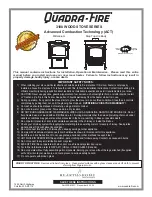
door (fig. 1, pos. 3). Stove has secondary air flow regulation due to improvement of
combustion and maintaining firebox glass clean. By combining primary air through
regulator on the ashtray door and secondary air via buttons above firebox door (fig.1,
pos. 12) desired combustion is achieved.
Stove has auxiliary tools which serve to facilitate maintenance of the stove. Use
these tools for shaking of the grid, it is to be inserted into the aperture of the shaker
which is located below ashtray door, then use slow motions forward and backward
during operation of the stove to enable passage of primary air.
Woods and briquettes are recommended for burning.
Do not use fuel oil, gasoline or similar as fuel for the stove, since usage of
liquid fuels creates conditions for damaging of stove and possible explosion
.
Attention!
•
Do not use organic residues, food residues, plastic objects, combustible and
explosive materials as fuel, since their combustion disturbs proper operation
of the stove and may cause damages and pollution of environment.
•
Increased external temperatures may cause weak draft in the chimney, thus it
is recommended more frequent burning in smaller quantities.
•
Usage of the stove in cases when meteorological conditions are bad and in
case of strong wind, it is to be maintained on proper sub-pressure in the
chimney. In indicated cases, smoke may return into the room in which stove is
located. Firing up is protracted in such cases.
We recommend burning on each one hour with the height of the fuel in the firebox up
to 15 cm with crosswise positioning of the woods due to higher draft.
Upon each filling, it is recommended to let stove to burn at least 30 minutes with
maximal power, in order to burn all evaporable ingredients which are the reason of
creation of condensate in the stove in this stage of combustion.
For proper operation of the stove, it is necessary to:
• regularly clean stove and chimney,
• regularly ventilate rooms due to good combustion,
• regularly remove ash from ashtray,
• regularly remove deposited gravel and unburned materials from the grid, using
cleaning accessories.
MANAGING OPERATION OF THE STOVE



































